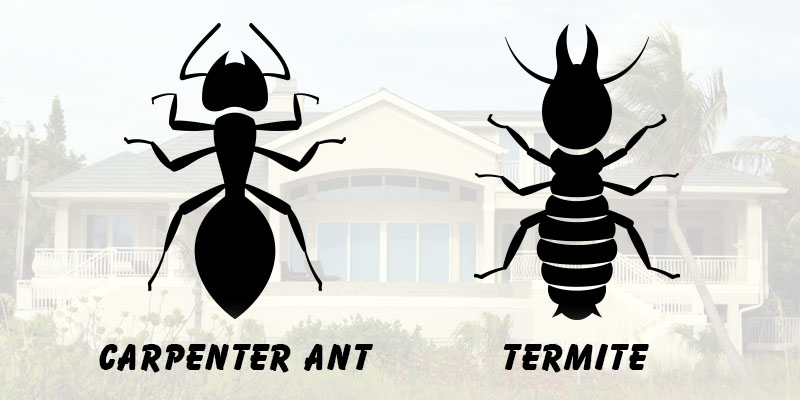Carpenter ants and termites are both wood-destroying insects that can cause significant damage to homes and businesses. While they may look similar at first glance, several key differences can help you distinguish between them. Because they share aesthetic appearances, it can make it very difficult to distinguish one from another. This is important since the two insects are not treated in the same way. So, knowing which is which is the first step in any treatment plan.
In what follows, we’ll explore the similarities and differences between carpenter ants and termites, and provide tips on how to identify them. We’ll also discuss the importance of early detection and professional pest control to prevent further damage. Continue to read on and you’ll have the information you need.
Carpenter Ants vs. Termites: Spotting the Differences
When it comes to thwarting home invaders, many homeowners worry about carpenter ants and termites. Both pests can cause damage, but they’re not the same. So, can carpenter ants be mistaken for termites? Let’s break this down.
Understanding Carpenter Ants
Carpenter ants are large black or reddish-brown insects. They often measure between 1/4 to 1/2 inch long. These little critters love to chew through wood, but not like termites. Carpenter ants dig tunnels in wood to create nests. They prefer moist wood, which often indicates water damage. If you spot them, don’t ignore them; they could lead to bigger problems over time.
The Appearance of Termites
Termites, on the other hand, are generally smaller than carpenter ants. Most termites are about 1/8 to 1/2 inch long, with a softer body and a little more tan or yellow tint. Unlike carpenter ants, termites consume wood, which means they can cause more harm faster. They usually cause serious structural damage, as they work silently behind the scenes.
Key Differences in Appearance
- Body shape. Carpenter ants have a pinched waist and rounded bodies. Termites have a more straight body, giving them a less defined waist.
- Antennae. Ants, including carpenter ants, have elbowed antennas. Termites have straight antennas.
- Wings. Swarmers of both species have wings, but termite wings are equal in length, while carpenter ant wings are different sizes.
Behavior Patterns: How They Differ
Carpenter ants are predominantly nocturnal. They tend to forage at night for food. They feast on sugary substances and proteins, which adds to their diet diversity. Termites, on the other hand, are more social and work together in colonies to munch on wood continuously, day and night.
Nesting Habits
Carpenter ants create nests in wood, but they don’t eat it – this is a key distinction. While carpenter ants might tunnel inside your wooden beams, looking for suitable living conditions, these pests won’t eat said wood. Conversely, termites build their nests within the wood they eat, leading to extensive damage over time.
Damage Indicators: What to Look For
Spotting the signs of either pest can help identify the threat. If you see a lot of sawdust around your home, you may have a carpenter ant problem. Termites, however, tend to leave behind mud tubes and peeling paint.
What Does It Mean?
If you find sawdust, remember that it may not always be a clear sign of carpenter ants. Termites also leave behind evidence. So, if you’re unsure, it’s best to call in the experts. It’s akin to recognizing a dog from a wolf; they may look similar, but their habits and effects can be vastly different.
Know Your Pests
Understanding the difference between carpenter ants and termites is crucial for any homeowner. It can save you time, money, and headache down the road. While they might look a bit alike at first sight, their behaviors, habitats, and the damage they cause tell completely different stories. Don’t let confusion between the two lead to neglect. Stay informed, keep an eye out, and maintain the health of your home. Your walls will thank you!
The Truth Behind DIY Carpenter and Termite Treatments: Why They Often Fail
Now, when it comes to dealing with carpenter ants and termites, many homeowners think they can tackle the problem themselves. DIY treatments seem simple and cost-effective, right? But what many don’t realize is that these home remedies often miss the mark. Let’s break down why DIY fixes for carpenter and termite infestations often fall short, and why professional pest control services tend to get better results. So, let’s take a look at the shortcomings of DIY carpenter and termite treatments.
- Incomplete treatment solutions. Most DIY treatments only scratch the surface. Homeowners often rely on sprays or bait traps, which might eliminate visible pests but fail to reach the entire colony or nest. Imagine trying to fix a leak with just a Band-Aid. The problem may look solved temporarily, but it’s only a matter of time before it reappears, often worse than before.
- Lack of knowledge and experience. Handling pests requires more than just surface-level knowledge. Homeowners may not recognize signs of infestations or understand pest behavior. For instance, termites and carpenter ants hide deep within wood or underground, making them hard to detect. Without proper training, a DIY attempt can easily overlook the main problem, leading to repeated infestations.
- Inadequate products. Retail pest control products often come with vague instructions. Many households think a quick spray will do the trick, but these over-the-counter solutions may not have the right active ingredients or potency. It’s not much different than trying to cook without a recipe; the results are hit or miss. You could end up with a meal that tastes bland or worse.
Why Professional Pest Control Services Excel
When it comes to battling unwanted critters in your home or business, the DIY approach often falls short. While store-bought sprays and traps might offer temporary relief, they rarely address the root of the problem. This is where professional pest control services shine. With their expertise, specialized equipment, and access to commercial-grade products, these pros can tackle infestations that would leave the average homeowner scratching their head.
Whether you’re dealing with resilient roaches, sneaky rodents, or destructive termites, understanding the advantages of professional pest management can be the first step towards a pest-free environment. Now, let’s go over the reasons why, beginning with professionals who have the necessary background.
- Expertise and experience. Professional pest control technicians have the training and experience the average homeowner lacks. They understand the life cycle of pests and can identify species, determining the best course of action. It’s not just about getting rid of the pests you see; it’s about thinking two steps ahead to prevent future issues.
- Access to advanced tools and treatments. Pest control professionals have access to powerful, specialized equipment and products unavailable to consumers. They use techniques and tools that target pests at their source, ensuring a thorough elimination. Think of it this way: using just a hammer when building a house won’t get you far. You need a complete set of tools to do the job right.
- Long-term solutions and prevention. While DIY treatments offer quick fixes, professional services provide long-term solutions. After eliminating an infestation, pest control experts can identify conditions that attract pests and make recommendations to prevent future issues. This proactive approach saves homeowners money and stress down the line.
All of this, plus many professional pest control companies offer warranties and follow-up services. If pests return after treatment, you can rely on them to come back and address the issue. It’s an important safety net—if your DIY method fails, it’s on you to figure out what went wrong.
Busting the DIY Myth
DIY projects can be fun and rewarding, but pest control isn’t the place to cut corners. The stakes are too high when it comes to structural damage and health risks associated with pests like termites and carpenter ants. If you’re dealing with an infestation, consider the benefits of calling in the professionals for a thorough and effective solution.
Don’t let confusion lead to costly damage! If you suspect carpenter ants or termites in your Jacksonville home, it’s time to take action. Trad’s Pest Control is here to help you identify and eliminate these wood-destroying pests before they compromise your property’s structural integrity.
Ready for peace of mind? Schedule a free inspection with our expert technicians today. We’ll accurately identify the pest issue, provide a tailored treatment plan, and protect your home from further damage.

